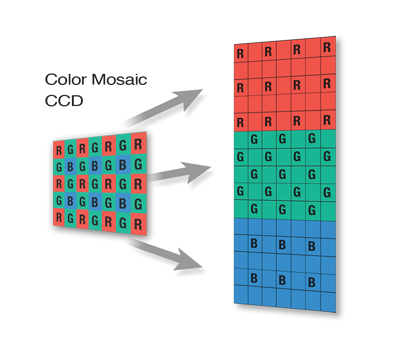Color Mosaic Sensor
Color Mosaic sensors look at light in its three primary colors using a color filter array applied directly to the sensor. The camera samples all three colors (red, green, blue) and combines them to reproduce the full visible color spectrum. Color mosaic sensors have a tiny red, green or blue color filters bonded to each pixel creating a “color mosaic” or “color filter array” pattern. Since each pixel in the sensor is able to measure the intensity of only one color, the intensity of the remaining two colors must be interpolated (averaged) based on the value of the neighboring pixels of the same color. For example, a pixel that has a green filter will directly measure the green intensity value, but the red and blue values must be interpolated based on the values of adjacent measured red and blue pixels.
The most common color mosaic patterns are the Bayer Pattern and Kodak TrueSense. There are several advantages that make the color mosaic method of capturing color images popular: 1) Only one exposure (single-shot) is required for the capture of dynamic events or moving specimens, 2) Cameras that use a single-shot imaging method tend to be smaller and can support the short back focal distance of the common C-Mount lens format, 3) The color filters are created as part of the sensor manufacturing process eliminating external filtering components and thereby reducing cost.
The color mosaic method also has some disadvantages, however. One is the color aliasing of small detail that results from the color interpolation algorithm. The second is a ~ 50% loss in the linear optical resolution due to interpolation of the 2×2 color mosaic pattern.


